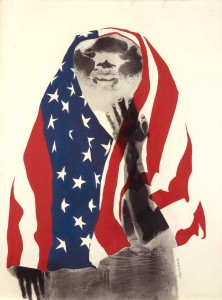Exhibition questions society
Though Los Angeles’ art history is rich, the focus given to West Coast art (compared to that given to New York artists) has been, in the past, somewhat flimsy. But “Pacific Standard Time: Art in L.A. 1945-1980,” the largest arts project to have ever taken place in the L.A. area, intends to fix this misconception by illuminating L.A. artists from the mid-20th century who shaped the landscape of modern art. Running from October through April 2012, the initiative plans to bring shows to more than 60 museums and educational institutions that will focus on the history of art in Los Angeles.

Social critique · Pieces like David Hammons’ “America the Beautiful” serve as symbols and intriguing, artistic innovations. - Photo courtesy of Hammer Museum
As part of the initiative, “Now Dig This! Art and Black Los Angeles 1960-1980,” a show that focuses on the legacy of Los Angeles’ African-American artists and their impact on the L.A. art scene, is running at the Hammer Museum through Jan. 8.
“Now Dig This!” features the works of prominent artists like Betye Saar, David Hammons and Fred Eversley, and these varying and diverse artists are paralleled by the 140 works that feature everything from the seminal to the avant-garde.
These works serve as an investigation of different time periods and artistic styles, while the relationship between African-American artists and the city of Los Angeles is examined closely through sculpture, painting and interview footage.
The show opens with a series of socially conscious works infused with American history. From Charles White’s painting “Harriet” (1972) to Melvin Edwards’ metal piece “Cotton Hangup” (1966), a variety of historical landmarks are expressed, ranging from the struggles of slavery to the civil rights movement.
The exhibit continues with a focus on “assemblage,” a collage-like artistic movement that appeared predominantly in the West Coast in the early 1960s. The exhibit emphasizes the effect that the 1965 Watts Rebellion had on the assemblage movement, as artists began to use artifacts from the riots in their multimedia pieces. Noah Purifoy’s “Watts Uprising Remains” (1966), for example, is featured alongside many other pieces that gleaned charred items from the debris of the riots.
Various assemblage pieces of Betye Saar are featured, as well as anecdotes about her prominent roles as a feminist and social activist in the 1960s. Many of her works use family items and tokens to express a sense of self, while others such as “To Catch a Unicorn” (1960) are more reflective of her thoughts on racism and sexism in America.
Assemblage takes on a relationship with Los Angeles in Dale Brockman Davis’ “Home is Where You Make It” (1970s); the piece’s bleakness comments on the promise Los Angeles held — and broke — for many African-Americans when they were greeted with racially restrictive housing covenants upon moving to California.
The exhibition also focuses on the landmarks — both literal and figurative — that influenced the L.A. art scene in the 1960s.
The birth of Gallery 32, a space that featured works by Betye Saar, Emory Douglas and David Hammons, while ultimately helping to foster the African-American artistic community in Los Angeles, is repeatedly mentioned in the exhibit. The 1966 show “66 Signs of Neon” is brought up throughout the exhibit as well, as many of the relics from the Watts riots displayed at the Hammer Museum were originally featured at the 1966 exhibit.
The cross-section of medias and styles examines the change and growth of what happened in the West Coast art world from the ’60s to the ’70s. David Hammons’s “America the Beautiful” (1968) is one of the most memorable pieces as far as construction. His “body prints” consist of the artist dousing himself in margarine, placing his body on a sheet of paper and sprinkling pigment on the surface.
On the more conventional side is Joe Overstreet’s painting “The New Aunt Jemima, 1964” (1970), which despite its commonplace medium shows a new side of an old story by empowering Aunt Jemima with a pancake-shooting machine gun.
Though “Now Dig This!” covers a broad spectrum of work by African-American artists, it focuses on a distinctive period of time that saw visual artists and activists come together to form a movement of people who wanted to question art, society and their city of Los Angeles.

Sounds like a great exhibit.. Very well written review..Can’t wait to see it!